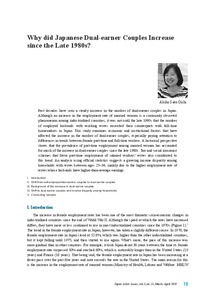Why did Japanese dual-earner couples increase since the late 1980s?

2019
3
13
March - April
15-29
economic development ; employment ; economic development ; married women ; labour force participation ; income
Gender equality & Women
https://www.jil.go.jp/english/jli/index.html
English
Bibliogr.;Statistics
"Past decades have seen a steady increase in the number of dual-earner couples in Japan. Although an increase in the employment rate of married women is a commonly observed phenomenon among industrialized countries, it was not until the late 1990s that the number of employed husbands with working wives exceeded their counterparts with full-time homemakers in Japan. This study examines economic and institutional factors that have affected the increase in the number of dual-earner couples, especially paying attention to differences in trends between female part-time and full-time workers. A historical perspective shows that the prevalence of part-time employment among married women has accounted for much of the increase in dual-earner couples since the late 1980s. Tax and social insurance schemes that favor part-time employment of salaried workers' wives also contributed to this trend. An analysis using official statistics suggests a growing income disparity among households with wives between ages 25–34, mainly due to the higher employment rate of wives whose husbands have higher-than-average earnings."
Digital;Paper
The ETUI is co-funded by the European Union. Views and opinions expressed are however those of the author(s) only and do not necessarily reflect those of the European Union or the ETUI.